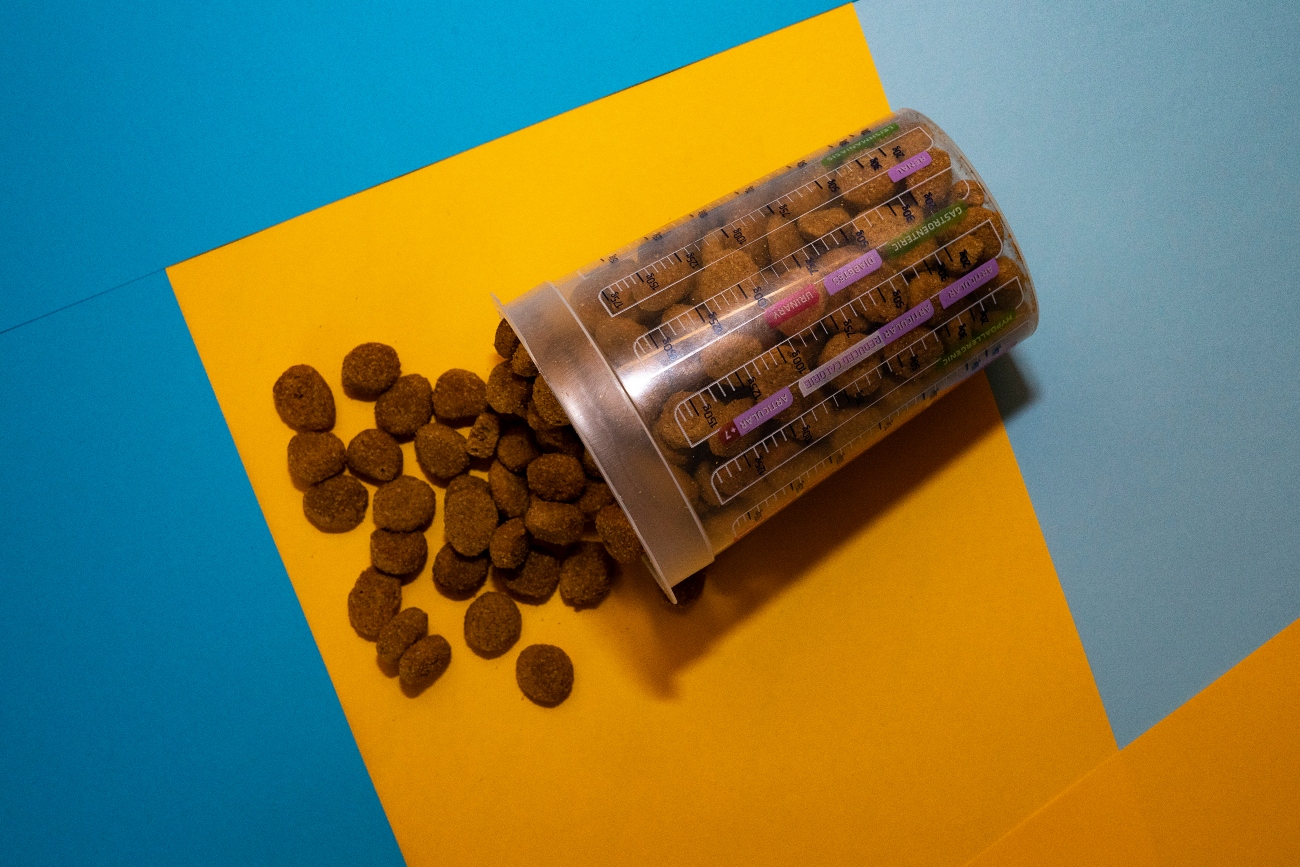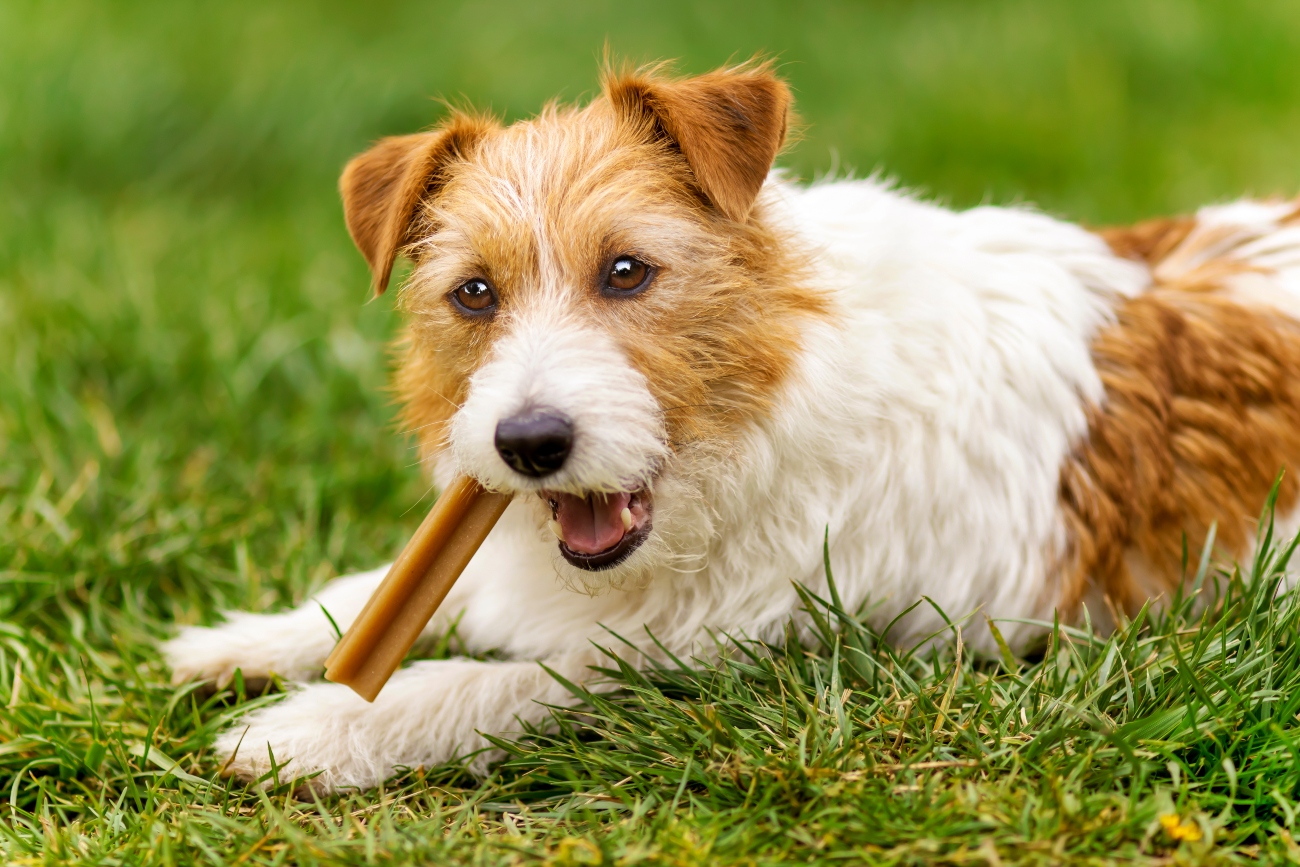
13 weight loss tips for older dogs
27th April, 2023
Is your older dog piling on the pounds? Learn how to tell if your pooch is overweight and some tips to help them slim down to a healthy size again.
We all gain an odd pound or two as we age – it’s normal – and the same goes for our four-legged friends. But how can you tell their weight is becoming an issue?
If Fido refuses to get out of bed in the morning and finds it hard to keep up with you on walks, it’s time to make a change. While a little extra dog might feel good to cuddle, it’s not doing their overall health any good. In fact, it puts them at a much higher risk of many medical conditions.
So, whether your pooch piled on the pounds during the pandemic or slowly increased in size over the years, don’t worry – you’re not alone.
According to a study by the Royal Veterinary College, 1 in 14 dogs weigh too much, with those aged 6 to 9 being most at risk of tipping the scales.
So, what can you do to help your greying hound lose a bit of extra weight? We’ve got you covered! Discover why it’s so important for your dog to keep slim, plus some tips to shed weight and keep it off.
We’ll also look at how senior dog insurance in the UK can help in an emergency if your overweight pet should ever become poorly.
How to tell your dog is overweight
The odd scrap of meat off your plate or slice of cheese while you’re making a sandwich won’t do any harm, will it?
While it’s extremely tough not to give into those longing stares from your senior pooch, fatty snacks and treats can quickly add a few inches to your dog’s waistline, damaging their health in the process.
Could your canine companion do with losing a pound or two? Look out for these signs:
- Excessive panting (you’ll need to rule out these other reasons for heavy breathing)
- Tiredness
- Abdominal sagging
- A larger, rounder face
- Struggling to see and feel their ribs, waist and spine
- Can’t get in and out of the car by themselves
- Reluctance to play games or move
Still not sure if they weigh too much? A quick visit to the vet will tell you their exact weight and whether you need to make any lifestyle changes.
A regular check-up like this isn’t included in senior dog insurance in the UK is essential to keep your pet happy and healthy. Not only can routine visits check for obesity, but your vet might spot other serious medical concerns before they become too serious.
Why does my dog need to lose weight?
With only an extra pound or so, your elderly dog might appear as happy as ever, but that doesn’t mean long-lasting damage isn’t happening internally. Many chronic conditions in older dogs progress slowly, making it hard to see the symptoms to begin with.
Obesity is linked to a host of medical concerns, including:
- Arthritis
- Kidney disease
- High blood pressure
- Cancer
- Pancreatitis
- Diabetes
- Heart disease
Getting your dog back in shape as soon as possible is key to a long and happy life as your pet ages, or you might see yourself claiming on your senior dog insurance in the UK for any one (or more) of the conditions mentioned.
How to help your dog lose weight
So your pooch needs to lose a few pounds. Not sure where to start? Follow our top tips to get them back in shape – and help them stay that way.
-
Visit the vet
Before you begin any sort of programme for your four-legged friend, take them to the vet.
Your vet will look, feel and weigh your dog to see how much they really need to lose and check whether their condition is due to an underlying cause. If it is, they’ll need to treat that, too.
Worried about the treatment costs and vet bills? As your dog gets older, they’ll likely need more emergency care, but your senior dog insurance in the UK can help with that.
-
Set a goal
Together with your vet, come up with a target weight for your older dog. When you have a goal to work towards, you’re much more likely to stick to the weight-loss plan (your vet can help with this, too).
Aim for a gradual, realistic weight loss and don’t make any drastic changes that could upset your canine – rapid weight loss can also be a problem!
-
Walk the daily minimum
Your senior pooch might have become a bit sluggish while out and about, but that doesn’t mean you should walk them less!
All canines need at least one walk a day. Some breeds love one long hike through the country, while others need lots of shorter walks. Check your breed on the Kennel Club website to see the minimum amount of daily exercise they need.
We’ve got lots of walking advice for older dogs elsewhere on our site, but here are a few top tips:
- Try short, frequent walks.
- Let your dog set the pace.
- Take plenty of breaks and provide water.
- Keep to a routine.
- Choose routes with easier terrain.
Finding walks more challenging with your older dog? Our favourite dog walking accessories might make things a little easier for them.
-
Increase indoor stimulation
Once the cold weather sets in, it can be harder than ever to get Rover out of bed. Older dogs are more susceptible to arthritis, causing stiffness and pain, so it’s no wonder they don’t feel like doing much.
Don’t worry, though. There are plenty of ways to keep them active indoors, too!
- Play hide and seek.
- Hide treats and play scent games (if they still have a good sense of smell).
- Get out a soft ball for indoor fetch.
- Switch the toys in your dog’s collection to keep them interested and stimulated.
Keeping busy is essential to weight loss as well as your furry friend’s overall well-being. Did you know that active dogs may be less likely to get dementia? So, not only is all that lazing around doing their waistline zero favours, it could also be causing cognitive decline and depression.
Worried your golden oldie is feeling down in the dumps? If you have senior dog insurance in the UK with Petwise, contact our 24-hour vet video service for quick, professional advice.
-
Understand the difference between begging and hunger
Does Fido follow you to the fridge at every opportunity hoping for a sneaky snack?
Most of us are guilty of slipping our canine companion the odd titbit under the table or a cube of cheese while making a sandwich, but is your dog really hungry?
Probably not.
The act of ‘begging’ is usually more to get your attention than actually needing to eat. Keep track of your dog’s meal times and resist the urge to share what’s on your plate.
There are also lots of human foods your pet shouldn’t be eating, which could see you claiming on your senior dog insurance in the UK for something far more serious than gaining a few extra pounds.
-
Measure meals

Have you ever poured out the actual serving suggestion of a bowl of cereal by weighing it? It’s probably a lot smaller than you’d think. When pouring freely, it’s easy to keep going, and the same goes for serving up your dog’s dinner.
Your pet’s needs might be quite a bit less than you’re feeding it, so speak with your vet about the right amount of food and make sure you weigh it every time.
-
Limit treats
It’s not only leftovers from your plate you need to be careful with. Lots of readily available canine treats from the shops contain lots of fat, too.
Think of doggy treats like you would sweets for a child to help limit the amount you give them. Are you using treats as a reward for training? Clickers also work well for positive reinforcement, but if you do want to give the odd treat, look for low-calorie options.
-
Get some puzzle feeders
Not only are puzzle feeders an excellent way to keep your pooch stimulated, but they also make those treats go a long way. If your dog goes weak at the knees for a spoonful of peanut butter, it’ll take them 10 times longer to lick it out of a puzzle feeding bowl or licky mat than right off the spoon!
A treat dispenser also works well if you have to leave your dog alone for a few hours.
Some, like the PawsOnlyUK Treat Dispenser, can also double-up for a game of fetch at the park to keep your pet in shape.
-
Keep a food diary
If you’re guilty of tossing your dog a treat without thinking twice, you might be surprised to see how much you’re actually feeding them, even if you do stick to regular meal times and portion sizes.
To get a good understanding of what your senior is actually eating, start a food diary. This will highlight all those ‘extras’ and help you cut down. Remember, your dog will always have an appetite for sausages whether they’re hungry or not, so stay strong!
-
Place food out of reach
When your canine companion smells something tasty, nothing will stop them from getting it – unless you keep it out of reach.
This means don’t leave anything out on the counter or in a cupboard they can get their paws into. You’ll be keeping them trim as well as making sure they don’t ingest anything they shouldn’t. The last thing you want is for them to be poisoned by your leftovers.
-
Consider a special diet
No two dogs are the same, so what worked for your friend’s pooch might not work for yours. Speak with your vet to come up with a diet that allows them to lose weight while still meeting their nutritional needs (especially important if they can’t eat certain foods for health reasons).
If your dog’s obesity is related to another medical concern, your vet might put them on a prescription diet. But doesn’t that cost a lot? It can do, but senior dog insurance in the UK might be able to help with paying for food.
Speak with the Petwise team if you have a policy with us about a senior food contribution.
-
Make it gradual
If you’re switching foods, going cold turkey can really upset your canine companion, so it’s important you make the transition slowly. Here’s an example of a food plan to follow:
- Days 1 & 2 – Give your dog 75% of its old food and 25% of the new one.
- Days 3 & 4 – Give 50% new food and 50% old.
- Days 5 & 6 – Feed them 75% of the new food and just 25% of the old.
- Day 7 – You should now be up to 100% new food.
You can use a similar technique with treats, slowly reducing the amount you give or the type over the course of a week. If you’re really having trouble getting your pet to eat the new food, give your vet a call.
-
Don’t give up
Perhaps the most important part of your weight loss programme is sticking to it. Like most things in your dog’s life, consistency is key. They’ll soon get used to their new meal plan and exercise regime, so don’t let your hard work go to waste.
And once you reach your goals, keep up the good habits. Get in touch with your vet again about what your dog should be eating now they’re at a healthy weight to avoid a rebound.
How long will it take for my dog to lose weight?
There’s no straightforward answer to this question. It all depends on how much excess baggage your pooch is carrying, but a healthy and safe rate of weight loss is around 1% of their overall weight a week.
So, if your pet is about 15% over what it should be, it could take a good few months to get them back into shape, but that’s healthy. Remember, anything too drastic could cause health issues related to rapid weight loss.
What treats can I give my dog if they’re overweight?
In reality, other than the odd one for training purposes, treats aren’t an essential part of your dog’s diet. They don’t need them, so they should be small – no larger than your fingernail in fact!
But if you do like to reward your loyal friend now and again, here are some healthy ideas:
- Kibble
- Plain, boiled chicken and turkey breast
- Peanut butter (make sure it doesn’t have xylitol)
- Pumpkin and squash
- Apples
- Carrots
- Broccoli
- Green beans
Make sure you steer clear of foods that can seriously harm your dog, like chocolate, blue cheese, grapes, onions and garlic.
Are some dogs at higher risk of obesity?
Like with most health concerns, certain factors mean some dogs are more prone to being overweight than others:
- Breed: Some pedigree dogs are at higher risk of obesity, including labradors, golden retrievers, pugs, basset hounds, cocker spaniels and dachshunds.
- Age: The older your pooch gets, the more likely they are to tip the scales.
- Sex: Although both sexes can become obese, it’s more common in female dogs.
What if my dog refuses to eat?
While some pet parents are struggling to keep their dogs from gaining too much weight, others have the opposite problem. As they age, it’s normal for canines to go off their food a little, but what happens if they stop eating altogether?
An extreme lack of appetite could be due to a serious medical issue, like:
- Cancer
- Pancreatitis
- Liver problems
- Dental issues
- Addison’s disease
To catch any illness early on and give your dog the best chance at survival, get them checked by the vet. It might simply be a slight loss of appetite due to old age, but it could signal an underlying problem.
How can I encourage my dog to eat more?
Once you’ve ruled out anything too serious, you can start working to get your pet’s appetite back. Here are a few ideas:
Mix dry and wet food
If you’ve been giving your dog dry food for most of their life, they might simply be ‘bored’ of what’s on offer. Try adding some wet food to appeal to their not-quite-so-strong sense of smell and encourage them with new textures.
Heat their food
We’re not talking about nuking your dog’s bowl in the microwave, but cold food right out the fridge isn’t too appetising either – at least not for your senior pooch. Gently warm their food in their microwave or on the hob just before serving it up.
Make it accessible
Perhaps your four-legged friend no longer eats as much because they’re not in a comfortable position? To avoid them bending down too much, place their bowl on a small stool or somewhere easy to reach.
Keep things calm
Senior dogs usually prefer somewhere peaceful to enjoy their food. So, give them their meals at quiet times of the day when they won’t be interrupted by kids coming home from school, a busy family dinner or other animal members of the household.
Protect your pooch with senior dog insurance in the UK

Obesity in dogs soon leads to various other health concerns, many of which turn into chronic conditions. Once your pet suffers from an illness and needs ongoing treatment, it makes it extremely difficult to find insurance to cover them in an emergency.
That’s why protecting your beloved pet with senior dog insurance in the UK while it's still healthy is so important. But why choose Petwise?
We believe that every dog deserves the best protection throughout their life, no matter their age. That’s why our specialist policies have no upper age limit and come with plenty of benefits to elderly canines and their owners, including:
- Dental cover as standard
- Senior food contribution
- 24-hour vet video consultations
- Easy online policy management at a time that suits you
You’ll also get farewell cover and access to our bereavement helpline to help with the loss of your faithful companion.
Don’t wait any longer to give your dog the ongoing protection it truly deserves.